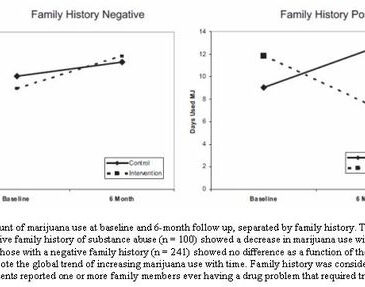The transition from high school to college includes a period of increased risk for marijuana use (Johnson, O’Malley, Bachmann, & Schulenberg, 2008). Web-based interventions might reduce the risk. Today’s STASH reviews a study of the effectiveness of a brief, personalized, web-based feedback intervention on marijuana-use measured at baseline (enrollment) and three and six months post intervention (Lee, Neighbors, Kilmer, & Larimer, 2010).
Methods
- Approximately 4000 incoming first-year students at a large public Northwest US university completed a screening survey that measured past-90 day marijuana use, consequences of use, and the family history of use.
- Among the 370 students who used marijuana in the past 90 days, 341 (about 8.5% of all students) completed the baseline survey, administered about one month before the beginning of the academic year.
- Half of these students were randomized to receive the intervention, which included personalized feedback based on participants’ responses to the baseline survey. The other half of participants received no feedback.
- Participants completed follow-up surveys at 3- and 6-months post-baseline. Retention rates for each follow-up exceeded 94%.
- The baseline and follow-up questionnaires asked students about their marijuana use and negative consequences of use in the previous 90 days.
Results
- Contrary to hypotheses, the intervention was not associated with reduced marijuana use at either follow-up assessment. Instead, marijuana use tended to increase between baseline and the 6-month assessment, irrespective of intervention.
- Results revealed an interaction between family history and treatment condition in predicting use changes from baseline to 6-month follow-up, F(1, 336) = 6.38, p<0.01, d=0.28. Students with a family history of drug use who received the intervention showed a decrease in marijuana use, while all other groups saw an increase.
- This study relies solely on self-report information about past marijuana use. Self report data about sensitive topics, such as illicit substance use, might not be reliable.
- The interaction of the participants and the website was not tracked. As such, we do not know if the participants read or understood the feedback. In the future, a fidelity check questionnaire or direct monitoring to assess how students viewed and interacted with the webpage may help clarify this issue.
Conclusion:
The authors present several possibilities about why the web-based feedback intervention was not effective. The authors speculate that successful in-person interviews might provide more relevant and relatable feedback compared to the online system. Furthermore, light or infrequent users may not believe they have a problem and may not take the feedback to heart, negating the effectiveness of the intervention. Future studies could explore interventions in different media. Marijuana is often consumed within a social context; SMS messages or emails at prime socializing times (e.g., early or late evenings or weekends) might be more effective than a web page viewed once during the day. With regard to the moderating role of family history, the authors speculate that the feedback is more relevant for those with a family history of substance abuse.
-Daniel Tao
What do you think? Please use the comment link below to provide feedback on this article.
References
Johnston, L.D., O’Malley, P.M., Bachman, J.G., Schulenberg, J.E.(2008). Monitoring the future national survey results on drug use, 1975–2007. Volume II: College students and adults ages 19–45 (NIH Publication No. 08–6418B). Bethesda, MD: National Institute on Drug Abuse.
Lee, C. M., Neighbors, C., Kilmer, J. R., & Larimer, M. E. (2010). A brief, web-based personalized feedback selective intervention for college student marijuana use: A randomized clinical trial. Psychology of Addictive Behaviors, 24(2), 265-273.





